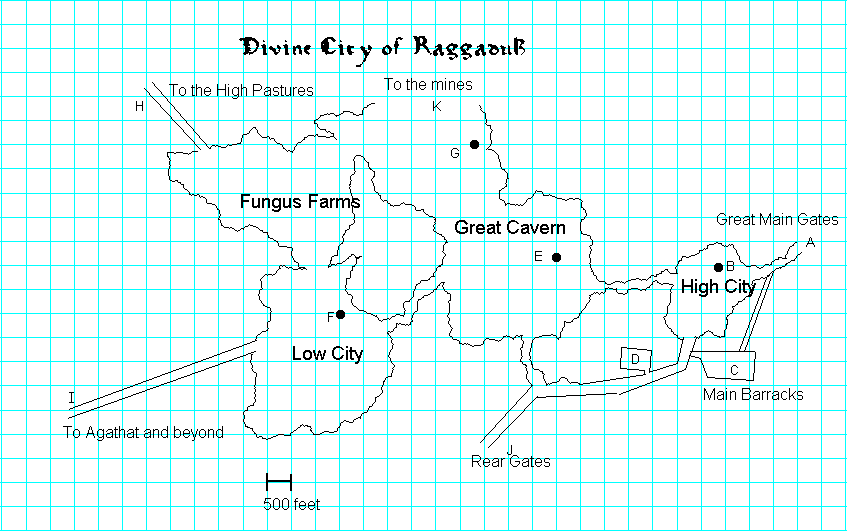| General Points of Interest |
|---|
| A | The Great Main Gates | The main gates of Raggaduk are solid oak doors heavily reinforced by the finest dwarven steel and marked with ancient runes placed by Thikar Kohrren hundreds of years ago. They have never been forced open from the outside. |
| B | The Temple of Kurek | The great temple of Kurek in Raggaduk is said to be the most magnificent in all the realms of the dwarves. It is a tribute to the skills of all the dwarven architects and sculpters of old. By tradition, the King of Raggaduk has also been the High Priest of this temple for six hundred years. |
| C | The Main Barracks | This cavern holds the main living quarters and training halls of the Raggaduk army, as well as military stores and civilian support. It accesses both the main entrance tunnel to the city and the tunnel just outside the Royal Quarter. |
| D | The Royal Quarter | This cavern houses the King's throneroom, audience halls and living quarters. It also holds the quarters of the King's Elite Guard, his personal shrine to Kurek and most other government offices. |
| E | Avik's Hall | The lodgings and study of Avik Thorkehr are is a simple low stone structure. Avik is usually the host to the few visitors the city see, and to accomodate the sight of surface-dwellers both exterior and interior of the home are well lit. |
| F | Temple of Vrakor | Raggaduk is the divine city, and as such it sees the favor of all the gods. Vrakor, dwarven god of war is not held in high esteem among the dwarves of the Deltarkan Mountains, but the Kings of Raggaduk see his importance and tolerate(barely) his worship in their city. The Temple of Vrakor is small, constructed of black marble with red accents, and positioned in the Low City, the poorer section of town. The quarter is home to much crime and violence, but no evidence can be found to pin it on Dargol Githon, the priest of Vrakor |
| G | The Temple of Elarkta | The temple to the goddess of stone is positioned in the northern part of the Great Cavern, as the city trails off to the entrance of the mines. The temple is a truly massive affair, crafted of granite and marble and steel. It resembles a fortress, providing shelter and protection in the unlikely event the gates of the city are breached. |
| H | Passage to the High Pastures | A passage leads off the cavern holding the fungus farms leading up to the high pastures. The pastures are green fields and forests high on the side of the mountains. The entrance is gated, but only lightly guarded as there is no easy approach to the pastures from below. The pastures are used to heard goats and sheep used for meat and wool by the dwarves, as well as supply mulch for the farms below. |
| I | The Grand Passage to Agathat | One of King Barrik's great accomplishments was the Coallition of Raggaduk, a treaty between Raggaduk and two smaller nearby cities, Agathat and Beiduk. With the completion of this treaty, trade between the three cities has greatly increased, and a tunnel was completed linking the cities. The passage leads from Raggaduk under the mountains to Agathat and from there to Beiduk. |
| J | The Rear Gates | Like the Great Main Gates, the Rear Gates are a great pair of steal reinforced wooden doors. The approach to the Rear Gates is less well known and difficult to approach, so they have been traditionally less well guarded. They are strengthened by runes, but carved by a lesser runesmith than Kohrren, and their strength has never been tried. |
| K | To the Mines | The lifeblood of the city is the rich veins of iron running along the city's northern border. In times past, all the iron the city needed was available just beyond the city limits. As time moves on, the miners have been heading further north and down in search of new places to dig their mines. As the extent of the caverns and caves to the north are unknown, there are regularly troops stationed at the city gates, and guards accompany the miners on their work. |
